Indigenous Peoples’ Perceptions of Their Food System in the Context of Climate Change: A Case Study of Shawi Men in the Peruvian Amazon
Abstract
1. Introduction
2. Materials and Methods
2.1. Conceptual Framework
2.2. Study Area
2.3. Methods
2.4. Positionality
3. Results
3.1. Individual Dimension
“Our women tell us to go find something to feed our kids. (…) sometimes when I go hunting, I cannot find anything, I even go further in the forest and nothing! Then I have to come back late, and I feel upset… You can no longer find anything here.”–Shawi adult.
“We have quantity in the forest, it is our natural farm, there is a lot of wealth there! (...) now there is less because sometimes people are destroying a lot to sell at the market. Our people are doing it, and it is no longer like before, (…) they chop the trees down, and they are killing them. For it to grow up, how many years? (…). Our next generation, what are they going to eat now?”–Shawi adult.
“I told my son: ‘you must work, you must make a fish farm so that you can feed your family’. I told him that, and asked him to raise chickens, pigs (…) There are no more animals in the forest, no more fish either. The forest will not recover. New generations will not know how to find food in the forest (…) I told them to raise domestic animals so they could eat. I raise my children telling them that.”–Shawi adult.
“On Sunday I had a little money; the loggers paid me 200 PEN. And I said, ‘I am going to buy soap’; we do not have soap and I walked with my little daughter. So I bought my soap and there was a little money left. Then I bought a kilo of collared peccary; 25 soles buys a kilo of collared peccary in Yurimaguas (…). Nowadays this is a luxury we can only afford a few times.”–Shawi adult.
3.2. Community Dimension
“I want the population to grow. There will be more people, more young people, more children. (…) There will be less game meat, but what can we do? (…) There is not going to be anything anymore (…). This little girl would not know the taste of agouti or deer…. This is what is happening now. My son has eaten deer and collared peccary, but this little girl has never, and she won’t.”–Shawi adult.
3.3. Societal Dimension
3.4. Perceived Climatic Changes
“When it floods, sometimes it takes our things (…). In the first flood, it was 2014, that time was at dawn, 1 am, so it was flooded when we were sleeping, so many chickens were taken.”–Shawi adult.
3.5. Mental-Health Implications
“The physician does not recognise reason like weather or increase of water streams. How can we go to the hospital if it’s a bad day? When the river is growing, I’m not going to go to the health service, I have to respect the river…The doctor wants you to come even when there is rain. He does not understand because in the city it is different. In the city you can go when it is rainy because there are motorbikes, there is public transport but here in the community, you have to walk, so you can’t get there, it’s very different.”–Shawi adult.
4. Discussion
5. Conclusions and Recommendations
Author Contributions
Funding
Institutional Review Board Statement
Informed Consent Statement
Data Availability Statement
Acknowledgments
Conflicts of Interest
References
- Pörtner, H.O.; Roberts, D.C.; Adams, H.; Adler, C.; Aldunce, P.; Ali, E.; Ara Begum, R.; Betts, R.; Bezner Kerr, R.; Biesbroek, R.; et al. Climate Change 2022: Impacts, Adaptation and Vulnerability; Contribution of Working Group II to the Sixth Assessment Report of the Intergovernmental Panel on Climate Change; Cambridge University Press: Cambridge, UK; New York, NY, USA, 2022; pp. 37–118. [Google Scholar] [CrossRef]
- International Food Policy Research Institute. 2022 Global Food Policy Report: Climate Change and Food Systems; IFPRI: Washington, DC, USA, 2022; ISBN 9780896294257. [Google Scholar]
- HLPE. Nutrition and Food Systems. A Report by the High Level Panel of Experts on Food Security and Nutrition of the Committee on World Food Security; HLPE: Rome, Italy, 2017. [Google Scholar]
- Vermeulen, S.J.; Campbell, B.M.; Ingram, J.S.I. Climate Change and Food Systems. Annu. Rev. Environ. Resour. 2012, 37, 195–222. [Google Scholar] [CrossRef]
- Tubiello, F.N.; Karl, K.; Flammini, A.; Gütschow, J.; Conchedda, G.; Pan, X.; Yue Qi, S.; Halldórudóttir, H.; Wanner, N.; Quadrelli, R.; et al. Pre-and Post-Production Processes along Supply Chains Increasingly Dominate GHG Emissions from Agri-Food Systems. Earth Syst. Sci. Data. 2022, 14, 1795–1809. [Google Scholar] [CrossRef]
- IPCC. Summary for Policymakers. In Climate Change and Land: An IPCC Special Report on Climate Change, Desertification, Land Degradation, Sustainable Land Management, Food Security, and Greenhouse Gas Fluxes in Terrestrial Ecosystems; Shukla, P.R., Skea, J., Calvo Buendia, E., Masson-Delmotte, V., Pörtner, H.-O., Roberts, D.C., Slade, P.Z.R., Connors, S., van Diemen, R., Ferrat, M., et al., Eds.; IPCC: Geneva, Switzerland, 2019; pp. 1–41. [Google Scholar]
- Smith, M.R.; Myers, S.S. Impact of Anthropogenic CO2 Emissions on Global Human Nutrition. Nat. Clim. Chang. 2018, 8, 834–839. [Google Scholar] [CrossRef]
- FAO. The Future of Food and Agriculture—Trends and Challenges; FAO: Rome, Italy, 2017; ISBN 978-92-5-109551-5. [Google Scholar]
- FAO; Alliance of Biodiversity International; CIAT. Indigenous Peoples’ Food Systems: Insights on Sustainability and Resilience in the Front Line of Climate Change; FAO, Alliance of Bioversity International, and CIAT: Rome, Italy, 2021; ISBN 978-92-5-134561-0. [Google Scholar]
- Ford, J.D.; Pearce, T.; McDowell, G.; Berrang-Ford, L.; Sayles, J.S.; Belfer, E. Vulnerability and Its Discontents: The Past, Present, and Future of Climate Change Vulnerability Research. Clim. Chang. 2018, 151, 189–203. [Google Scholar] [CrossRef]
- Naylor, A.; Ford, J.; Pearce, T.; Van Alstine, J. Conceptualizing Climate Vulnerability in Complex Adaptive Systems. One Earth 2020, 2, 444–454. [Google Scholar] [CrossRef]
- Turner, N.; Plotkin, M.; Kuhnlein, H. Global Environmental Challenges to the Integrity of Indigenous Peoples’ Food Systems. In Indigenous Peoples’ Food Systems & Well-Being; Kuhnlein, H., Erasmus, B., Spigelski, D., Burlingame, B., Eds.; FAO: Rome, Italy, 2013; pp. 23–38. ISBN 978-92-5-107433-6. [Google Scholar]
- FAO; IFAD; UNICEF; WFP; WHO. The State of Food Security and Nutrition in the World 2018: Building Climate Resilience for Food Security and Nutrition; FAO: Rome, Italy, 2018; ISBN 9789251305713. [Google Scholar]
- Lemke, S.; Delormier, T. Indigenous Peoples’ Food Systems, Nutrition, and Gender: Conceptual and Methodological Considerations. Matern. Child Nutr. 2017, 13, e12499. [Google Scholar] [CrossRef]
- Kuhnlein, H.V. Introduction: Why Are Indigenous Peoples’ Food Systems Important and Why Do They Need Documentation? In Indigenous Peoples’ Food Systems: The Many Dimensions of Culture, Diversity and Environment for Nutrition and Health; FAO: Rome, Italy, 2009; pp. 1–7. ISBN 9789251060711. [Google Scholar]
- Egeland, G.M.; Harrison, G.G. Health Disparities: Promoting Indigenous Peoples’ Health through Traditional Food Systems and Self-Determination. In Indigenous Peoples’ Food Systems & Well-Being: Interventions & Policies for Healthy Communities; Kuhnlein, H., Erasmus, B., Spigelski, D., Burlingame, B., Eds.; FAO: Rome, Italy, 2013; pp. 9–23. ISBN 978-92-5-107433-6. [Google Scholar]
- Egeland, G.; Charbonneau-Roberts, G.; Kuluguqtuq, J.; Kilabuk, J.; Okalik, L.; Soueid, R.; Kuhnlein, H. Back to the Future: Using Traditional Food and Knowledge to Promote a Healthy Future among Inuit. In Indigenous Peoples’ Food Systems the Many Dimensions of Culture Diversity and Environment for Nutrition and Health; Kuhnlein, H., Erasmus, B., Spigelski, D., Eds.; FAO: Rome, Italy, 2009; pp. 9–23. ISBN 9789251060711. [Google Scholar]
- Kuhnlein, H.V.; Erasmus, B.; Spigelski, D.; Burlingame, B. Indigenous Peoples’ Food Systems & Well-Being: Interventions & Policies for Healthy Communities; FAO: Rome, Italy, 2013; ISBN 978-92-5-107433-6. [Google Scholar]
- MINAM. El Perú y El Cambio Climático. Tercera Comunicación Nacional Del Perú a La Convención Marco de Las Naciones Unidas Sobre El Cambio Climático; MINAM: Lima, Peru, 2016. [Google Scholar]
- IPCC Summary for Policymakers. Global Warming of 1.5 °C. An IPCC Special Report on the Impacts of Global Warming of 1.5 °C above Pre-Industrial Levels and Related Global Greenhouse Gas Emission Pathways, in the Context of Strengthening the Global Response to the Threat of Climate Change; Masson-Delmotte, V., Zhai, P., Pörtner, H.O., Roberts, D., Skea, J., Shukla, P.R., Pirani, A., Moufouma-Okia, W., Péan, C., Pidcock, R., et al., Eds.; Cambridge University Press: Cambridge, UK, 2018; pp. 175–311. [Google Scholar]
- Creed-Kanashiro, H.; Roche, M.; Tuesta Cerrón, I.; Kuhnlein, H.V. Traditional Food System of an Awajun Community in Peru. In Indigenous Peoples’ Food Systems: The Many Dimensions of Culture, Diversity and Environment for Nutrition and Health; Kuhnlein, H.V., Erasmus, B., Spigelski, D., Eds.; FAO: Rome, Italy, 2009; pp. 59–82. ISBN 978-92-5-106071-1. [Google Scholar]
- Zavaleta, C.; Berrang-Ford, L.; Llanos-Cuentas, A.; Cárcamo, C.; Ford, J.; Silvera, R.; Patterson, K.; Marquis, G.S.; Harper, S. Indigenous Shawi Communities and National Food Security Support: Right Direction, but Not Enough. Food Policy 2017, 73, 75–87. [Google Scholar] [CrossRef]
- Paredes, M.; Kaulard, A. Forest as ‘Nature’ or Forest as Territory? Knowledge, Power, and Climate Change Conservation in the Peruvian Amazon. J. Peasant Stud. 2022, 1–22. [Google Scholar] [CrossRef]
- Paredes, M.; Kaulard, A. Fighting the Climate Crisis in Persistently Unequal Land Regimes: Natural Protected Areas in the Peruvian Amazon. J. Clean. Prod. 2020, 265, 121605. [Google Scholar] [CrossRef]
- Mohamed Shaffril, H.A.; Ahmad, N.; Samsuddin, S.F.; Samah, A.A.; Hamdan, M.E. Systematic Literature Review on Adaptation towards Climate Change Impacts among Indigenous People in the Asia Pacific Regions. J. Clean. Prod. 2020, 258, 120595. [Google Scholar] [CrossRef]
- Johnson, D.E.; Parsons, M.; Fisher, K. Indigenous Climate Change Adaptation: New Directions for Emerging Scholarship. Environ. Plan. E Nat. Space 2022, 5, 1541–1578. [Google Scholar] [CrossRef]
- Van Bavel, B.; Ford, L.B.; Harper, S.L.; Ford, J.; Elsey, H.; Lwasa, S.; King, R. Contributions of Scale: What We Stand to Gain from Indigenous and Local Inclusion in Climate and Health Monitoring and Surveillance Systems. Environ. Res. Lett. 2020, 15, 083008. [Google Scholar] [CrossRef]
- Middleton, J.; Cunsolo, A.; Jones-Bitton, A.; Wright, C.J.; Harper, S.L. Indigenous Mental Health in a Changing Climate: A Systematic Scoping Review of the Global Literature. Environ. Res. Lett. 2020, 15, 053001. [Google Scholar] [CrossRef]
- Barnett, J.; Tschakert, P.; Head, L.; Adger, W.N. A Science of Loss. Nat. Clim. Chang. 2016, 6, 976–978. [Google Scholar] [CrossRef]
- Tschakert, P.; Ellis, N.R.; Anderson, C.; Kelly, A.; Obeng, J. One Thousand Ways to Experience Loss: A Systematic Analysis of Climate-Related Intangible Harm from around the World. Glob. Environ. Chang. 2019, 55, 58–72. [Google Scholar] [CrossRef]
- Cunsolo, A.; Ellis, N.R. Ecological Grief as a Mental Health Response to Climate Change-Related Loss. Nat. Clim. Chang. 2018, 8, 275–281. [Google Scholar] [CrossRef]
- Cunsolo, A.; Harper, S.L.; Minor, K.; Hayes, K.; Williams, K.G.; Howard, C. Ecological Grief and Anxiety: The Start of a Healthy Response to Climate Change? Lancet Planet. Health 2020, 4, e261–e263. [Google Scholar] [CrossRef]
- Bennett, N.J.; Blythe, J.; Tyler, S.; Ban, N.C. Communities and Change in the Anthropocene: Understanding Social-Ecological Vulnerability and Planning Adaptations to Multiple Interacting Exposures. Reg. Environ. Chang. 2016, 16, 907–926. [Google Scholar] [CrossRef]
- Du Bray, M.V.; Wutich, A.; Brewis, A. Hope and Worry: Gendered Emotional Geographies of Climate Change in Three Vulnerable U.S. Communities. Weather. Clim. Soc. 2017, 9, 285–297. [Google Scholar] [CrossRef]
- Lawrance, E.L.; Thompson, R.; Newberry Le Vay, J.; Page, L.; Jennings, N. The Impact of Climate Change on Mental Health and Emotional Wellbeing: A Narrative Review of Current Evidence, and Its Implications. Int. Rev. Psychiatry 2022, 34, 443–498. [Google Scholar] [CrossRef]
- Hayes, K.; Blashki, G.; Wiseman, J.; Burke, S.; Reifels, L. Climate Change and Mental Health: Risks, Impacts and Priority Actions. Int. J. Ment. Health Syst. 2018, 12, 28. [Google Scholar] [CrossRef] [PubMed]
- Petrasek MacDonald, J.; Cunsolo Willox, A.; Ford, J.D.; Shiwak, I.; Wood, M.; Wolfrey, C.; Baikie, M.; Andresen, A.; Nochasak, N.; Piercy, W.; et al. Protective Factors for Mental Health and Well-Being in a Changing Climate: Perspectives from Inuit Youth in Nunatsiavut, Labrador. Soc. Sci. Med. 2015, 141, 133–141. [Google Scholar] [CrossRef] [PubMed]
- Câmpeanu, C.N.; Fazey, I. Adaptation and Pathways of Change and Response: A Case Study from Eastern Europe. Glob. Environ. Chang. 2014, 28, 351–367. [Google Scholar] [CrossRef]
- Breilh, J. La Determinación Social de La Salud Como Herramienta de Transformación Hacia Una Nueva Salud Pública (Salud Colectiva). Rev. Fac. Nac. Salud Pública 2013, 31, S13–S27. [Google Scholar]
- Solis, M.F. Lo Que la Mina Se Llevó. Estudio de Impactos Psicosociales y Socioecosistémicos Tras la Salida de la Empresa Kinross en las Comunidades Ubicadas en la Zona de Influencia Directa del Proyecto Fruta del Norte; Ediciones La Tierra: Quito, Ecuador, 2016; ISBN 978-9978-320-98-3. [Google Scholar]
- Ford, J.D.; King, N.; Galappaththi, E.K.; Pearce, T.; McDowell, G.; Harper, S.L. The Resilience of Indigenous Peoples to Environmental Change. One Earth 2020, 2, 532–543. [Google Scholar] [CrossRef]
- Ford, J.D.; Keskitalo, E.C.H.; Smith, T.; Pearce, T.; Berrang-Ford, L.; Duerden, F.; Smit, B. Case Study and Analogue Methodologies in Climate Change Vulnerability Research. Wiley Interdiscip. Rev. Clim. Chang. 2010, 1, 374–392. [Google Scholar] [CrossRef]
- Hofmeijer, I.; Ford, J.D.; Berrang-Ford, L.; Zavaleta, C.; Carcamo, C.; Llanos, E.; Carhuaz, C.; Edge, V.; Lwasa, S.; Namanya, D. Community Vulnerability to the Health Effects of Climate Change among Indigenous Populations in the Peruvian Amazon: A Case Study from Panaillo and Nuevo Progreso. Mitig. Adapt. Strateg. Glob. Chang. 2013, 18, 957–978. [Google Scholar] [CrossRef]
- Zavaleta Cortijo, C. Food Insecurity and Climate Change Adaptation Among Peruvian Indigenous Shawi; McGuill University: Montréal, QC, Canada, 2017. [Google Scholar]
- Zavaleta, C.; Berrang-Ford, L.; Ford, J.; Llanos-Cuentas, A.; Cárcamo, C.; Ross, N.A.; Lancha, G.; Sherman, M.; Harper, S.L. Multiple Non-Climatic Drivers of Food Insecurity Reinforce Climate Change Maladaptation Trajectories among Peruvian Indigenous Shawi in the Amazon. PLoS ONE 2018, 13, e0205714. [Google Scholar] [CrossRef]
- Instituto Nacional de Estadística e Informática (INEI). III Censo de Comunidades Nativas 2017. Resultados Definitivos; INEI: Lima, Peru, 2018. [Google Scholar]
- Gonzáles, L. La Enfermedad y Lo Humano Entre Los Shawi de La Alta Amazonía. Rev. Antropol. Iberoam. 2018, 13, 213–232. [Google Scholar] [CrossRef]
- Huertas, B.; Chanchari, M. Agua, Cultura y Territorialidad en el Pueblo Shawi del Río Sillay; Terra Nuova: Lima, Peru, 2011. [Google Scholar]
- MINCUL. Base de Datos de Pueblos Indigenas u Originarios. Available online: https://bdpi.cultura.gob.pe/pueblos/shawi (accessed on 12 October 2022).
- Chanchari, N.; Pua, J. Como Un Panal de Avispas. In El Ojo Verde: Cosmovisiones Amazónicas; AIDESEP, Fundacion Telefónica: Lima, Peru, 2000. [Google Scholar]
- Gonzáles, L. Un Lugar Para Los Shawi En La Historia de Maynas. Anthropologica 2015, 33, 249–266. [Google Scholar]
- Ormaeche, M.M.G.; Barclay, F. ASIS del Pueblo Shawi 2008 Region Loreto; Dirección General de Epidemiología (DGE): Lima, Peru, 2008; Available online: http://www.dge.gob.pe/portal/docs/intsan/asis_shawi15.pdf (accessed on 12 October 2022).
- Pitman, N.; Vriesendorp, C.; Alvira, D.; Johnston, M.; Ruelas Inzunza, E.; Lancha Pizango, A.; Sarmiento Valenzuela, G.; Alvarez-Loayza, P.; Homan, J.; Wachter, T.; et al. Perú: Cordillera Escalera-Loreto; The Field Museum, Science and Education: Chicago, IL, USA, 2014; Volume 26. [Google Scholar]
- Ministerio del Ambiente; Ministerio de la Mujer y Poblaciones Vulnerables. Plan de Acción en Género y Cambio Climático; Ministerio del Ambiente: Lima, Peru, 2016; Available online: https://www.minam.gob.pe/cambioclimatico/wp-content/uploads/sites/11/2015/12/PLAN-G%C3%A9nero-y-CC-16-de-JunioMINAM+MIMP.pdf (accessed on 12 October 2022).
- Braun, V.; Clarke, V. Using Thematic Analysis in Psychology. Qual. Res. Psychol. 2006, 3, 77–101. [Google Scholar] [CrossRef]
- Ministerio de Salud. Política Nacional Multisectorial de Salud Al 2030; Ministerio de Salud: Lima, Peru, 2020. [Google Scholar]
- Ministerio de Salud. Aprueban La Política Sectorial de Salud Intercultural. El Peruano. 2016, 582230–582240. Available online: https://busquedas.elperuano.pe/download/url/aprueban-la-politica-sectorial-de-salud-intercultural-decreto-supremo-n-016-2016-sa-1363166-6 (accessed on 12 October 2022).
- O’Reilly, J.; Isenhour, C.; McElwee, P.; Orlove, B. Climate Change: Expanding Anthropological Possibilities. Annu. Rev. Anthropol. 2020, 49, 13–29. [Google Scholar] [CrossRef]
- Crate, S. Climate and Culture: Anthropology in the Era of Contemporary Climate Change. Annu. Rev. Anthropol. 2011, 40, 175–194. [Google Scholar] [CrossRef]
- Orlove, B.; Chiang, J.; Cane, M. Forecasting Andean Rainfall and Crop Yield from the Influence of El Niño on Pleiades Visibility. Nature 2000, 403, 68–71. [Google Scholar] [CrossRef]
- Simpson, N.P.; Clarke, J.; Orr, S.A.; Cundill, G.; Orlove, B.; Fatorić, S.; Sabour, S.; Khalaf, N.; Rockman, M.; Pinho, P.; et al. Decolonizing Climate Change–Heritage Research. Nat. Clim. Chang. 2022, 12, 210–213. [Google Scholar] [CrossRef]
- Sempertegui, A. Decolonizing the Anti-Extractive Struggle: Amazonian Women’s Practices of Forest-Making in Ecuador. J. Int. Women’s Stud. 2020, 21, 122–138. [Google Scholar]
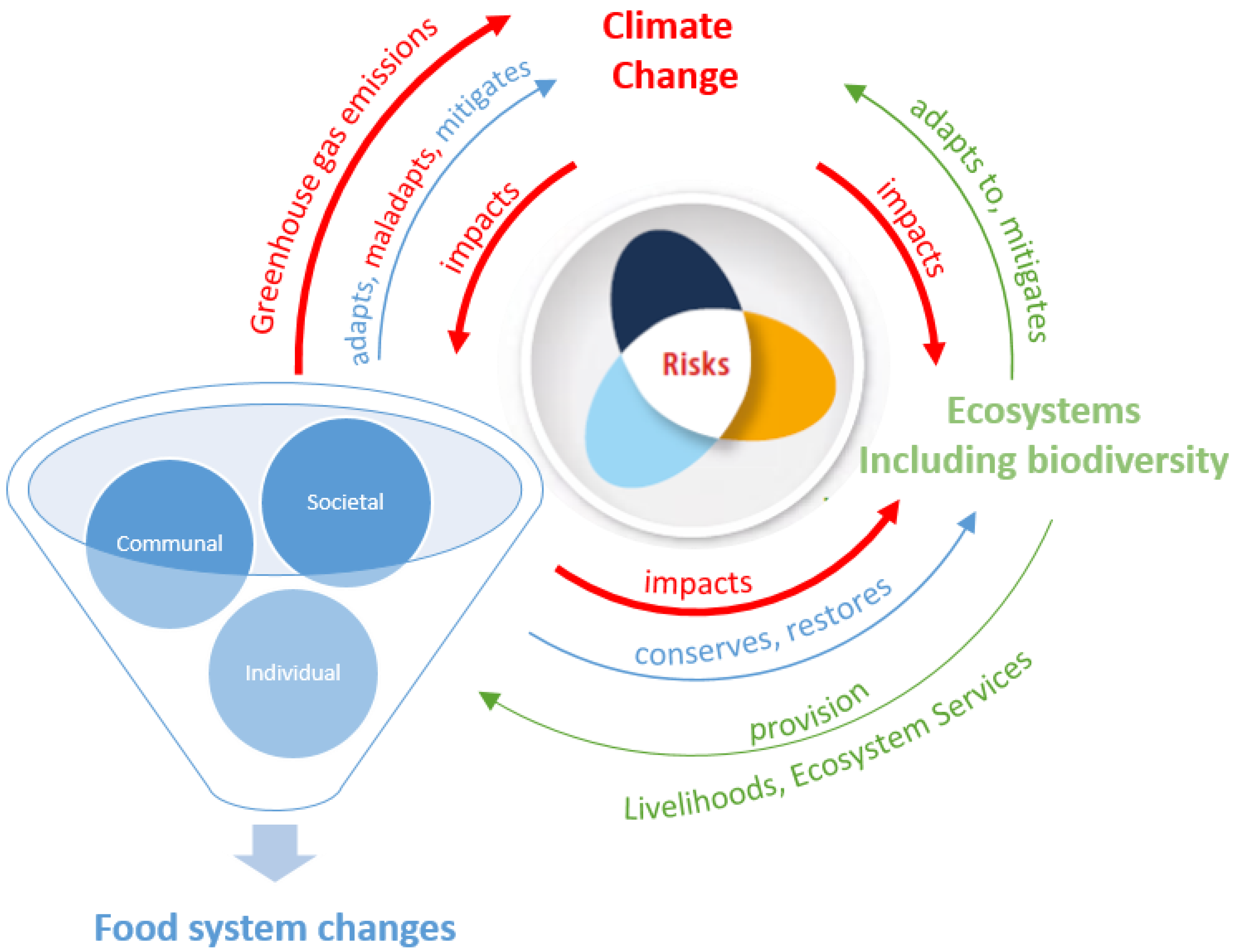
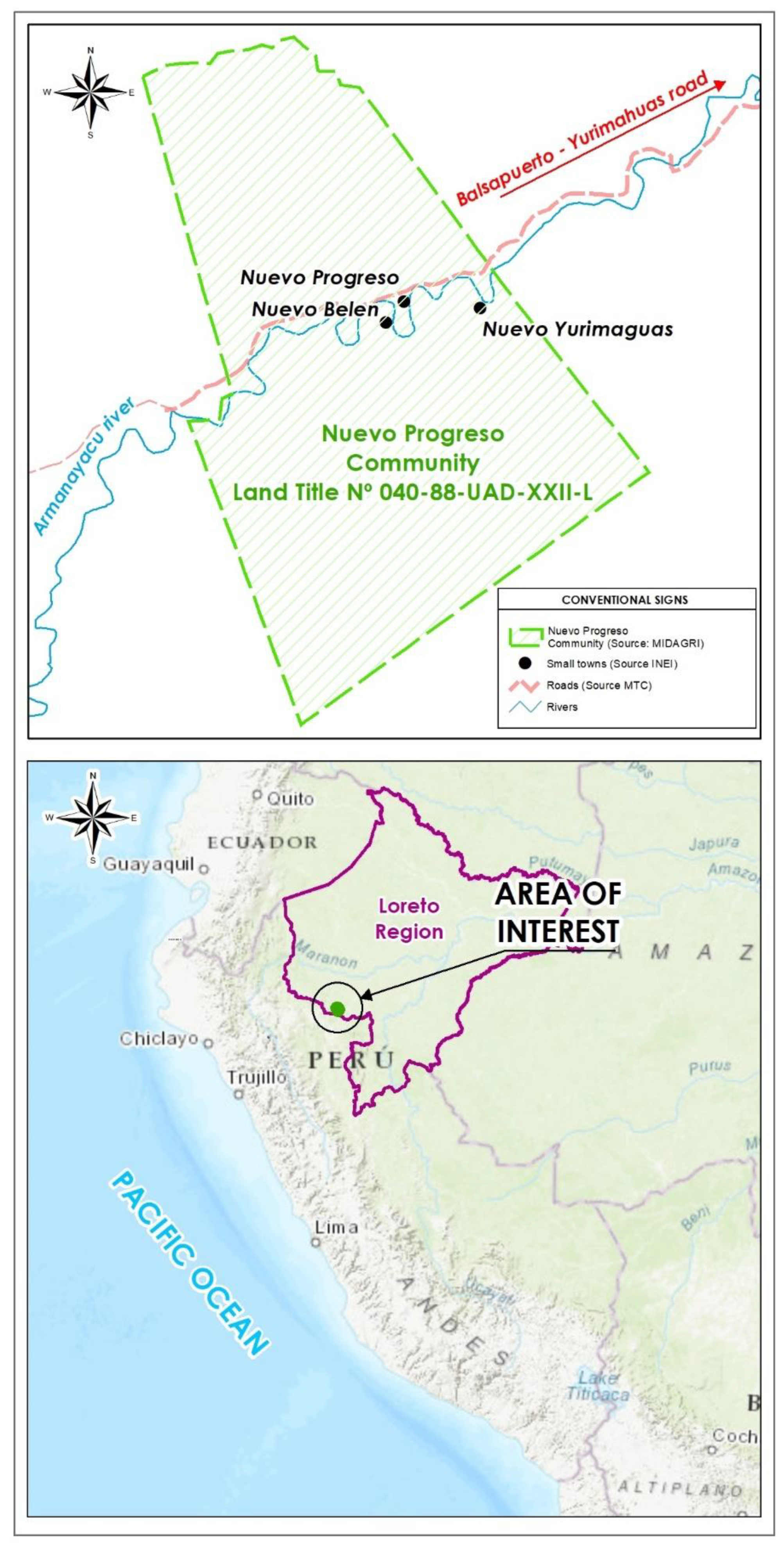
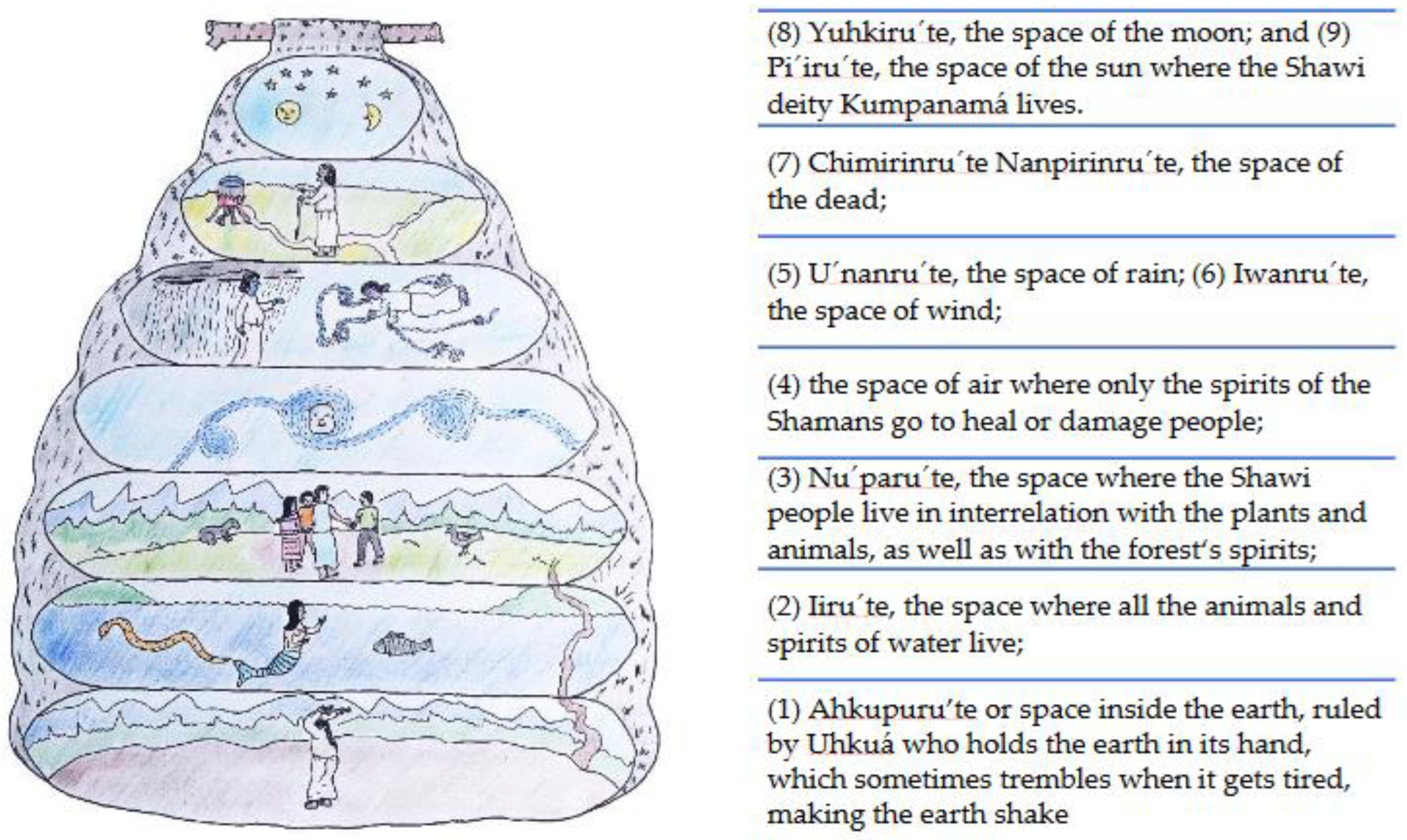
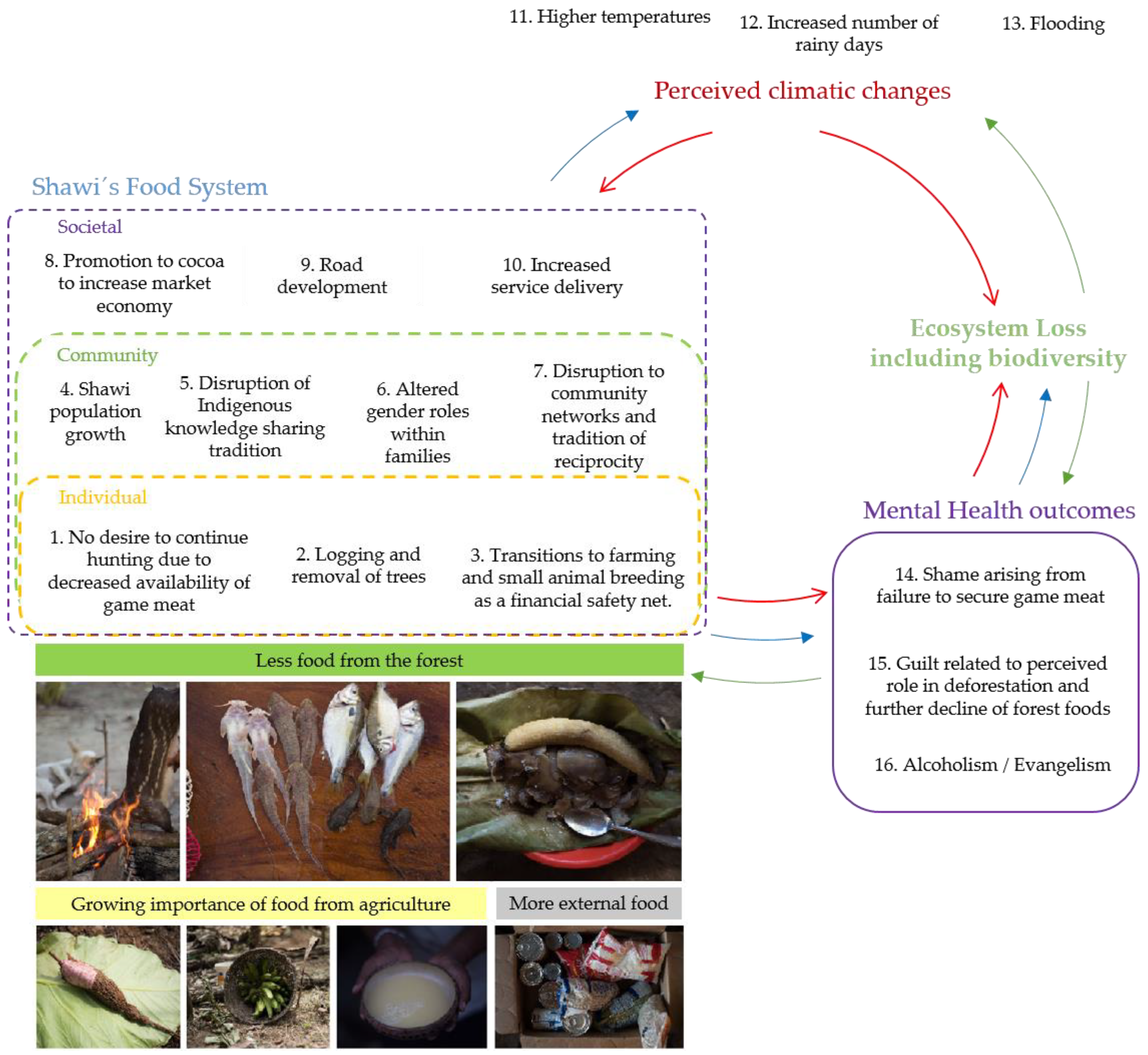
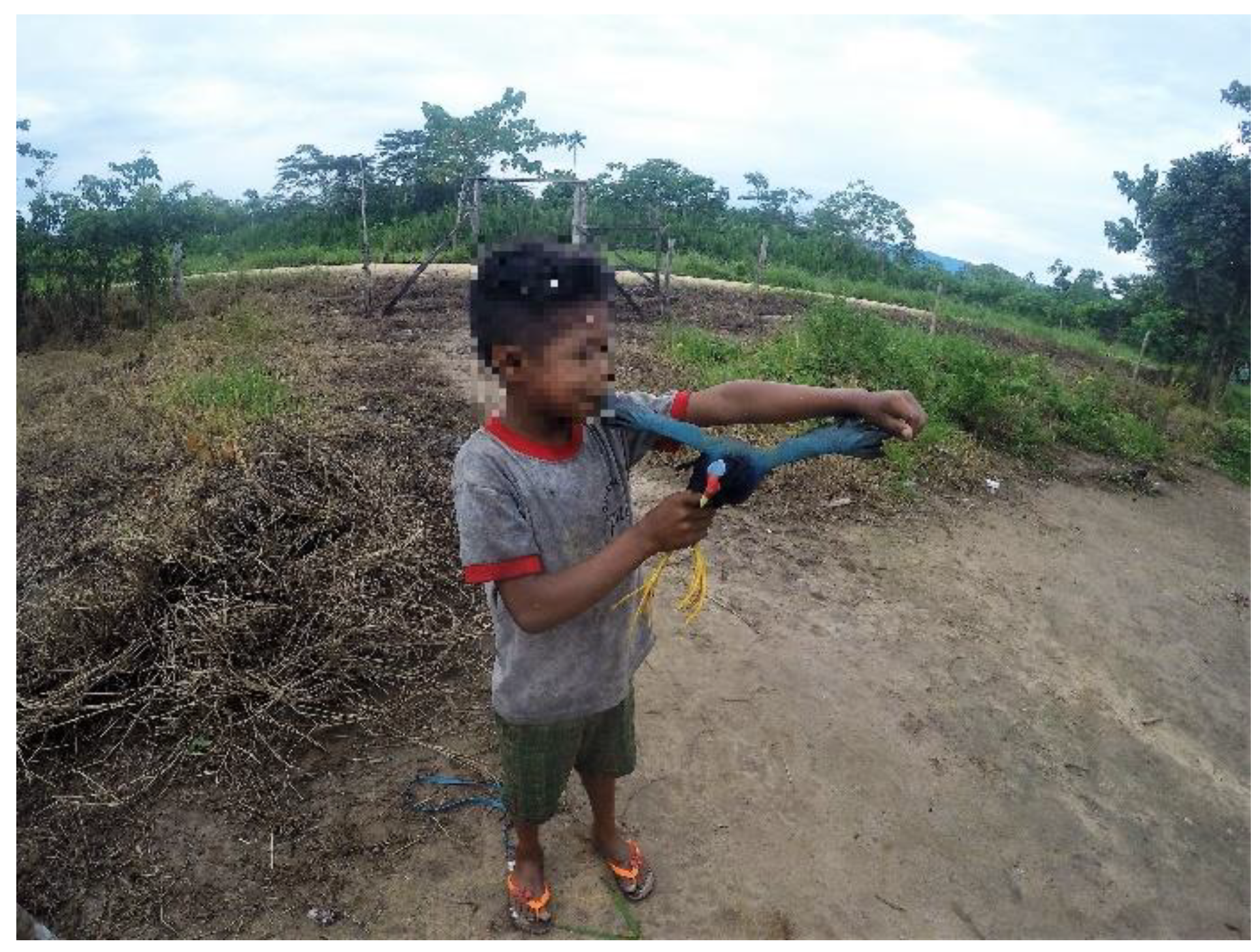
Publisher’s Note: MDPI stays neutral with regard to jurisdictional claims in published maps and institutional affiliations. |
© 2022 by the authors. Licensee MDPI, Basel, Switzerland. This article is an open access article distributed under the terms and conditions of the Creative Commons Attribution (CC BY) license (https://creativecommons.org/licenses/by/4.0/).
Share and Cite
Arotoma-Rojas, I.; Berrang-Ford, L.; Zavaleta-Cortijo, C.; Ford, J.D.; Cooke, P. Indigenous Peoples’ Perceptions of Their Food System in the Context of Climate Change: A Case Study of Shawi Men in the Peruvian Amazon. Sustainability 2022, 14, 16502. https://doi.org/10.3390/su142416502
Arotoma-Rojas I, Berrang-Ford L, Zavaleta-Cortijo C, Ford JD, Cooke P. Indigenous Peoples’ Perceptions of Their Food System in the Context of Climate Change: A Case Study of Shawi Men in the Peruvian Amazon. Sustainability. 2022; 14(24):16502. https://doi.org/10.3390/su142416502
Chicago/Turabian StyleArotoma-Rojas, Ingrid, Lea Berrang-Ford, Carol Zavaleta-Cortijo, James D. Ford, and Paul Cooke. 2022. "Indigenous Peoples’ Perceptions of Their Food System in the Context of Climate Change: A Case Study of Shawi Men in the Peruvian Amazon" Sustainability 14, no. 24: 16502. https://doi.org/10.3390/su142416502
APA StyleArotoma-Rojas, I., Berrang-Ford, L., Zavaleta-Cortijo, C., Ford, J. D., & Cooke, P. (2022). Indigenous Peoples’ Perceptions of Their Food System in the Context of Climate Change: A Case Study of Shawi Men in the Peruvian Amazon. Sustainability, 14(24), 16502. https://doi.org/10.3390/su142416502









